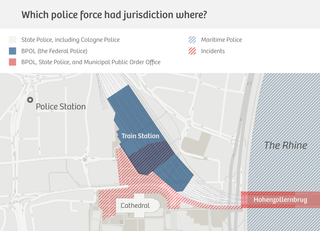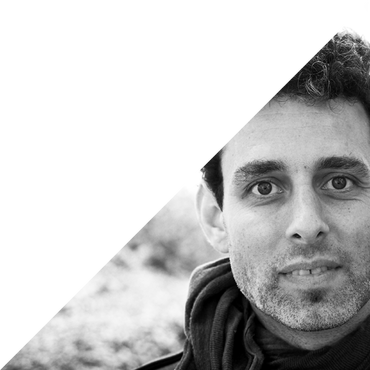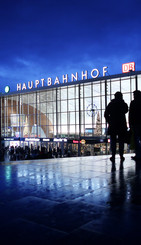This timeline is part of our reconstruction of the events in Cologne last New Year’s Eve:
December 31, 8:00 p.m.

The square outside the train station is already 60 to 70% full of New Year’s Eve revelers, according to Detlef Maschetzky of the German Federal Police (Bundespolizei, or BPOL).
December 31, 8:40 p.m.
Günter Reintges of the Cologne police observes 400 to 500 men “with an ethnic background” at the station. They seem to be drunk and are throwing firecrackers.
December 31, 9:30 p.m.
An initial briefing takes place with all the authorities present – including the Federal Police (Bundespolizei, or BPOL), Cologne’s public transportation operator (Kölner Verkehrs-Betriebe, or KVB), the State Police of North Rhine-Westphalia (Polizei Nordrhein-Westfalen, or NRW State Police), the North Rhine-Westphalia Maritime Police (Wasserschutzpolizei Nordrhein-Westfalen, or MP), and the Municipal Public Order Office (Ordnungsamt).
December 31, 9:45 p.m.
Some 38 police officers patrolling a nearby demonstration are sent home between 9:05 and 9:45 p.m. Later, this decision would be severely criticized by North Rhine-Westphalia’s Interior Department in a report on the night.
December 31, 10:00 p.m.

The State Police officers – in Cologne to monitor festivities around the city that night – start their shift. There are a total of 142 police officers in this group, including 83 from the Riot Police. Seventy-six officers are sent to patrol historical downtown, including the bridges over the Rhine and an urban boulevard called the Cologne Ring, both popular party spots.
The other police officers are deployed across downtown and the police station near the train station (Polizeiinspektion 1, or PI1). Though the State Police is responsible for the city’s festivities, it does not have jurisdiction at the station. The Federal Police, BPOL, is in charge here. There are 67 BPOL officers on duty on New Year’s Eve. That’s 22 more than the previous year.

December 31, 10:14 p.m.
A radio call comes in to the PI1 police station from a police vehicle, signalling a critical situation involving people throwing firecrackers near the station and the cathedral, amid thousands of people. The officer states that they don’t have sufficient capacity to respond. PI1 neither responds nor sends support.
December 31, 10:25 p.m.
In response to an unruly crowd near the station, the State Police decides to send 10 additional officers to the station.
December 31, 10:45 p.m.
Members of the public inform a BPOL officer that the situation in and around the station is deteriorating, according to a leaked police report that was later verified by the federal government.
December 31, 10:50 p.m.
All 83 Riot Police officers gather at the station.
December 31, 11:00 p.m.
The atmosphere becomes increasingly aggressive. People on the square outside the train station ignore the State Police’s efforts to calm the crowd.
The police notices an increase in fireworks being set off carelessly. According to a State Interior Department report, there were between 1,000 and 1,500 people present at the time. And Maschetzky told a parliamentary inquiry committee that there were as many as 2,000 to 3,000 people present at the height of the festivities. This number corresponds with the estimates given to us by witnesses. Maschetzky also told the committee that part of the crowd was drunk and aggressive.
December 31, 11:15 p.m.
Günter Reintges, Operational Commander that night, decides to evacuate the area in front of the station, including the stairs that lead to the cathedral on the square, in order to prevent accidents with fireworks and potential panic in the crowd.
December 31, 11:30 p.m.
Reintges communicates with the State Police Central Support Services (Landesamt für Zentrale Polizeiliche Dienste, or LZPD) about the situation at the station. They offer more manpower to keep the situation under control. This decision, as it turns out, doesn’t even have that much to do with the specific developments taking place that evening, but would have been made during a quieter New Year’s Eve as well. And yet Reintges declines the offer, because he doesn’t see the need for additional forces. According to the State Interior Department, the decision was a grave error and led to the loss of control of the situation.
December 31, 11:45 p.m.
According to a number of statements, the State Police start to evacuate parts of the square from 11:30 p.m. and 11:45 p.m. At the same time, BPOL blocks the station’s main hall so people can no longer enter the station. According to the State Police, the evacuation outside went smoothly. Things calmed down on the square, the State Interior Department corroborates. But witnesses we spoke to have refuted this claim.
December 31, 11:55 p.m.
Some 2,500 people are stuck at the train station, according to the Interior Department. BPOL closes tracks 10 and 11, where regional trains depart from, because it’s overcrowded and because people are walking across the tracks. Police officers are summoned to the platforms, but this means they can’t be deployed elsewhere. This decision was criticized later by Ralf Jäger from the State Interior Department. Jörg Breetzmann, head of the Municipal Public Order Office’s security service, which is jointly responsible for the bridge leading out of the station and over the Rhine, later said that the city had not been informed about the blockade.
Midnight on December 31

Happy New Year! Hundreds of people gather on Hohenzollernbrug, the bridge behind the station, to watch the fireworks. The first complaints about sexual harassment and robbery are recorded at the PI1 police station.
January 1, 12:02 a.m.
Between 12:02 and 12:35 a.m. – statements about the time vary – the German railroad company (Deutsche Bahn, or DB), halts all train traffic because people are walking on the tracks. The trains start up again at about 1:15 a.m. In the meantime, the station continues to get fuller by the minute because people want to go home.
January 1, 12:27 a.m.
The State Police reopens the area around the station so people can go home.
January 1, 12:30 a.m.
The State Police assumes that the situation is under control, which is why 30 of its officers are sent to other parts of town. Ten of these officers are later called back to the station after the State Police received reports of sexual harassment there. The State Interior Department’s press office has told us that they didn’t know the exact whereabouts of many police officers from this point on.
January 1, 12:35 a.m.
After the fireworks show and the evening’s festivities, people flow from the city and the Hohenzollernbrug towards the train station, which is becoming even more crowded now. People are boisterous. According to Maschetzky’s statement before the state committee investigating the incidents of the night, people on the platforms were screaming and there was a real danger of a “stampede.” He also stated that he had tried to contact people at the Municipal Public Order Office – responsible for the bridge – to make them aware of this dangerous situation.
January 1, 12:50 a.m.
State Police officers encounter several women who say they were sexually assaulted by groups of men. Some women are crying and say that the men touched their pubic area.
January 1, 1:00 a.m.
Reintges visits the PI1 police station and is informed that many people have filed reports of robbery and sexual assault. While Reintges has testified he was informed about a multitude of reports of sexual assault an hour after midnight, Maschetzky told the state investigative committee that he informed Reintges of the reported crimes earlier in the evening.
January 1, 1:20 a.m.
Police officers in and near the station are ordered to be alert to robbery and sexual violence.
January 1, 4:00 a.m.

The situation calms down. Police officers in and near the station record 32 reports of crime throughout the night. More people wanted to file reports, but the police was not equipped to handle the high volume.
January 1, 5:05 a.m.
The first police officers are sent home, reducing the number of officers on duty.
January 1, 8:00 a.m.
The police operation officially ends.
We wrote this story with editorial support from International Editor Maaike Goslinga.
— Translated from Dutch by Mark Speer and Erica Moore, with terminology assistance from Maria Sherwood Smith.
 News after the fact. Reporting on New Year’s Eve in Cologne, with hindsight
The events of New Year's Eve in Cologne, Germany, have long since disappeared from the front page, but the police investigation continues. What would a news report of that night look like in light of what we know now – four months later?
News after the fact. Reporting on New Year’s Eve in Cologne, with hindsight
The events of New Year's Eve in Cologne, Germany, have long since disappeared from the front page, but the police investigation continues. What would a news report of that night look like in light of what we know now – four months later?
 Why we’re running stories on Cologne four months after the fact
Today we bring you a story on the shocking New Year’s Eve events in Cologne. Why now? What’s the rationale for a months-long investigation? Editor Karel Smouter briefly explains the idea behind this approach.
Why we’re running stories on Cologne four months after the fact
Today we bring you a story on the shocking New Year’s Eve events in Cologne. Why now? What’s the rationale for a months-long investigation? Editor Karel Smouter briefly explains the idea behind this approach.







